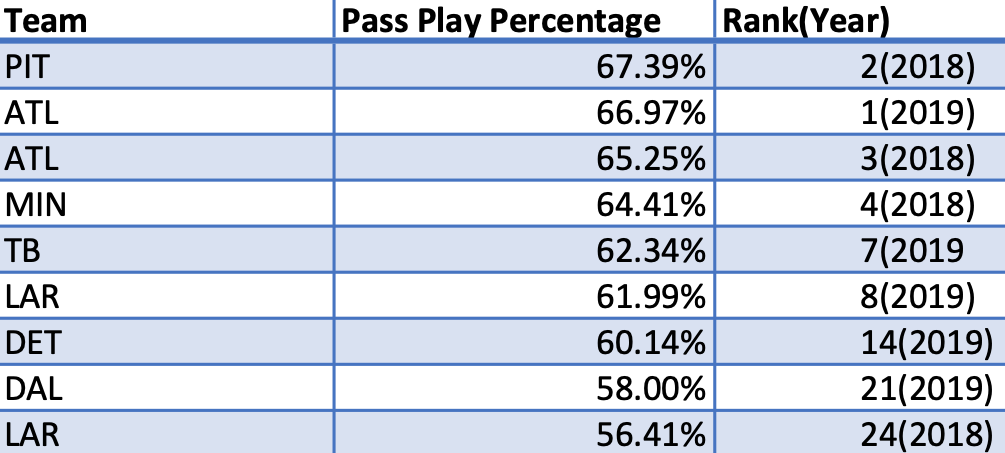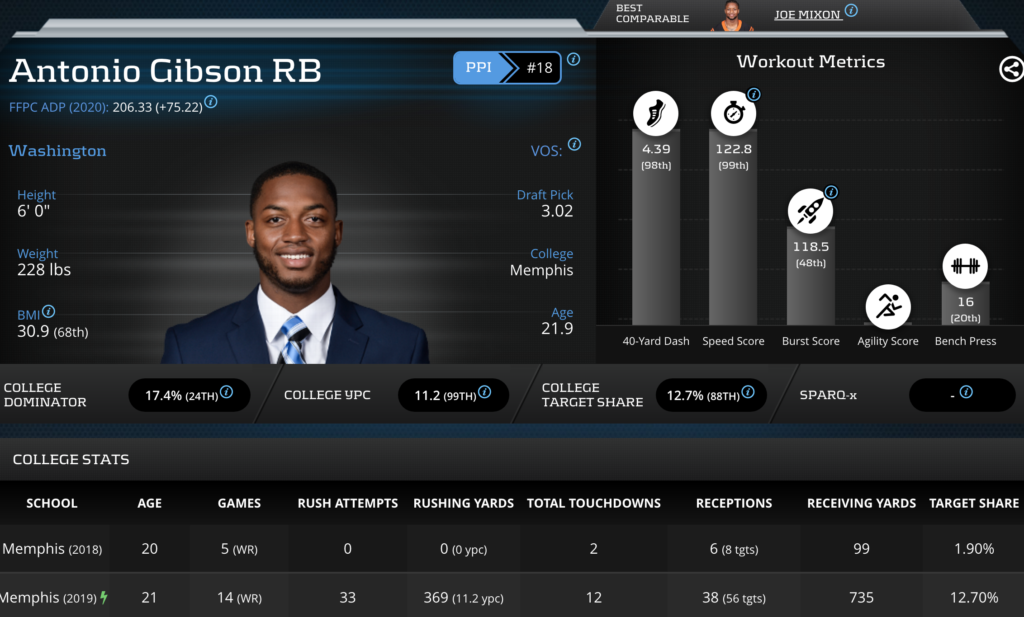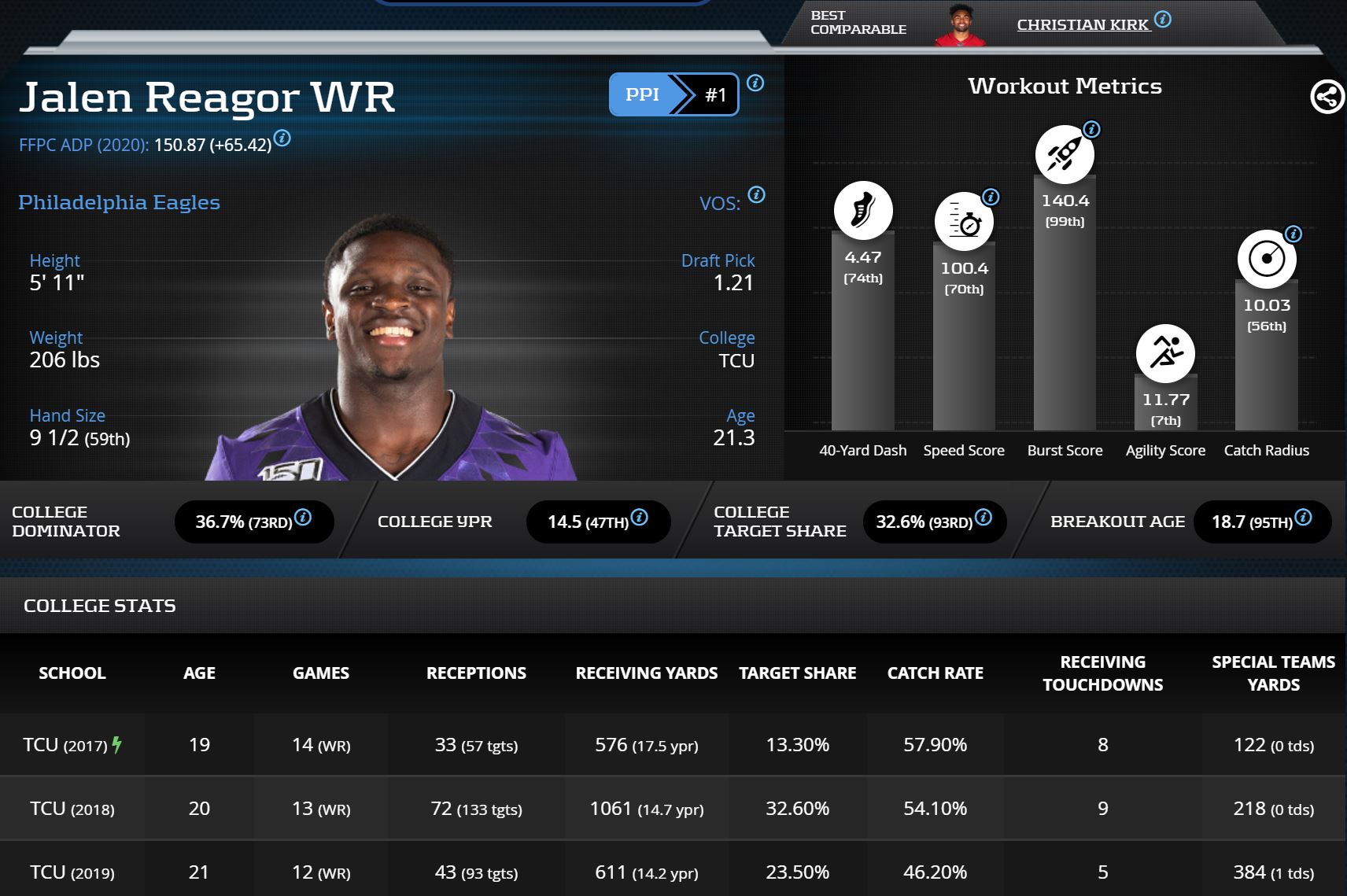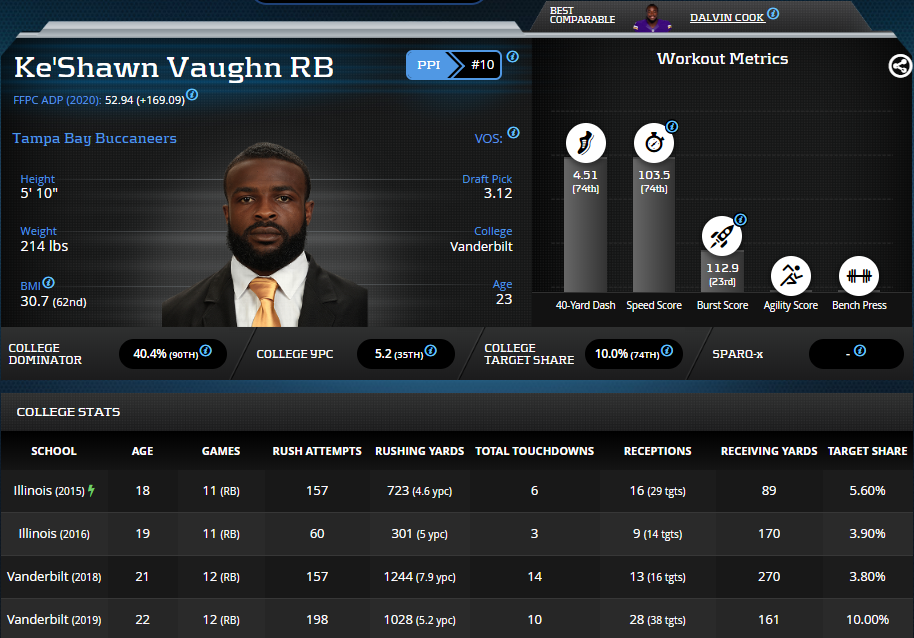With the NFL Draft all wrapped up, it’s now officially Rookie Draft Season. Now is the time to make last-minute adjustments to our rookie rankings in correspondence with draft capital and landing spots. Using advanced stats and metrics, we’re looking at the players who profile as the biggest risers and fallers in dynasty leagues following the 2020 NFL Draft.
Risers
Jalen Reagor – Philadelphia Eagles
During the pre-draft process, Jalen Reagor was projected as a Round 2 pick in most NFL circles. He was left outside of Evan Silva’s final first round mock draft and was Matt Miller’s No. 55 player off the board in his seven-round mock. At pick No. 21, Reagor hit his absolute ceiling in terms of draft capital. He was selected four slots after CeeDee Lamb on draft day. Investing that high in a receiver with such a deep class shows how the Philadelphia front office feels about Reagor at the next level. He will have the opportunity to produce on day one with the Eagles.
With an 18.7 (95th-percentile among qualified wide receivers) Breakout Age, Reagor has proven that he can command targets instantly in the Eagles offense. Especially when considering his competition. Heading into 2020, the Eagles have 128 (No. 9) vacated targets and were a dream landing spot for any first round wide receiver. He will have no problem competing for targets in an injury-prone receiver room featuring Alshon Jeffery and DeSean Jackson. Jeffery has only played in 23 of 32 games in the last two years, and Jackson only played in three games last year. Reagor will have plenty of opportunities to establish himself as the alpha in year one.
The flaw most Reagor doubters point to is his low 46.2-percent college Catch Rate. This number can easily be explained when looking at TCU’s quarterback play. According to Pro Football Focus, only 61.4-percent of Reagor’s 93 targets were deemed catchable in 2019. When adjusting in relation to the number of targets that were catchable (57) and his receptions (43), his Catch Rate was actually 75.4-percent. With the Eagles, he walks into an extremely different situation with Carson Wentz under center. Wentz will help elevate Reagor’s game with his 7.6 (No. 5) Accuracy Rating, 69 (No. 10) Deep Ball Attempts, and 45 (No. 5) Danger Plays. He will have accurate passes thrown his way for the first time in his career along with a quarterback who is not afraid to sling it.
Reagor comes into a situation as the instant No. 1 receiver in Philadelphia and should become an instant fantasy beneficiary as someone with serious contested catch and deep-ball abilities. His quarterback is not afraid to throw deep or into coverage, allowing for plenty of opportunities for splash plays. He has the chance to be a pumped up Brandin Cooks and should be rising up every dynasty player’s rookie board.
Ke’Shawn Vaughn – Tampa Bay Buccaneers
It’s time to come to terms with the fact that Ke’Shawn Vaughn is better than Ronald Jones. Vaughn possesses the workhorse size and skillset that Jones lacks. At Vanderbilt, Vaughn posted a 10-percent (74th-percentile) Target Share and averaged a class second-best 5.41 Yards Created per Attempt. He also possesses workhorse size and speed at 5-10, 214-pounds with a 30.7 (62nd-percentile) BMI to go along with his 103.5 (74th-percentile) Speed Score. With these metrics in mind, Dalvin Cook is his Best Comparable Player. Cook in Tampa Bay’s new high-powered offense? Yes, please. Similar to Vaughn, Cook’s greatest concern post-draft was splitting touches with Latavius Murray. As we know, that didn’t last long. At USC, Jones posted a 4.3-percent (18th-percentile) Target Share and averaged a class second-worst 3.97 Yards Created Per Carry. He lacks the skillset of an every-down back in the NFL and is undersized with a 28.6-percent (18th-percentile) BMI.
To combat his lack of receiving in college, people might point to Jones’ 41 (No. 34) targets last season. This can be rationalized away when seeing that he competed for touches with the not so dynamic duo of Peyton Barber and Dare Ogunbowale. In addition to poor competition, Tampa Bay passed on 62.7-percent of their plays (No. 7), pumping up his receiving stats due to negative game scripts caused by Jameis Winston’s turnovers. At this point, Jones’ only leg up over Vaughn is his draft capital. While Jones did go a full round ahead of Vaughn in his respective draft, Bruce Arians holds no allegiance to Jones, who was drafted a year before Arian’s hire. At the 3.12, Arians invested Day 2 draft capital on Vaughn, revealing to the fantasy community his true beliefs about Jones as a running back.
With Tom Brady under center, Tampa Bay is slated to make a huge step forward in 2020. An offense highlighted by Brady, Chris Godwin, Mike Evans, Rob Gronkowski, and O.J. Howard is the perfect situation for any running back to land in. Vaughn hit the jackpot. In 2020, the Buccaneers will be a top 10 scoring offense in the league. In addition to the weapons on the outside, their offensive line finished the year at No. 7 on PFF’s final offensive line rankings for 2019. They drafted Tristan Wirfs at No. 13 overall. Let that sink in. Vaughn walks into a weak running back room on a high-scoring offense with a Top 10 offensive line. With Barber’s departure, Tampa has 215 (No. 3) carries available, along with 10 (No. 4) inside the 5. Vaughn has a legitimate shot to be an RB1 in his rookie year.
Fallers
Jerry Jeudy – Denver Broncos
When Jerry Jeudy was drafted No. 15 overall to the Denver Broncos, there was almost an audible crash as he fell down many analysts’ rankings over the weekend. Jeudy was drafted alongside K.J. Hamler, Tyrie Cleveland, and Albert Okwuegbunam. Not only does he walk into a crowded receiving room with only 58 (No. 30) vacated targets, but he brings three more pass catchers with him on draft day. Denver already has an established alpha in Courtland Sutton who netted a 26.1-percent (No. 8) Target Share in his 2019 breakout season. Jeudy becomes a low ceiling asset playing second fiddle to Courtland Sutton for the foreseeable future. In the modern NFL, some may argue that offenses can support more than one top-24 receiver in Fantasy Points Per Game. Below is a chart that disproves that idea for Jeudy on the Broncos:

Pass Play Percentage among teams with multiple Top-24 wide receivers in Fantasy Points Per Game in 2018-2019.
In 2019, Denver passed the ball on 57.13-percent (No. 24) of their plays. In the last two seasons, only two teams have been able to support multiple top-24 receivers in Fantasy Points Per Game with a Pass Play Percentage lower than 60-percent. In 2019, the Dallas Cowboys supported both Michael Gallup and Amari Cooper. This was due to Dak Prescott being a hyper-efficient quarterback. Last year, he posted a +22.8 (No. 4) Production Premium, 48.7-percent (No. 2) Deep Ball Completion Percentage, and a 72.1-percent (No. 8) True Completion Percentage to list a few of his efficiency metrics. The Cowboys ranked No. 2 in Offensive DVOA in 2019.
In 2018, the Los Angeles Rams also supported two Top 24 wide receivers with a below 60-percent Pass Play Percentage. That was the year Todd Gurley turned the Rams into an NFC Championship powerhouse. That year, they ranked No. 2 in Offensive DVOA. See the trend here? The Denver Broncos would have to have a Top 5 offense to support both Sutton and Jeudy. The last time they did that was in 2014 with Peyton Manning. Drew Lock definitely has a wide range of outcomes with such a small sample, but I’m confident he won’t rise to Manning-level production in the near future.
Check out Jerry Jeudy on PlayerProfiler’s Updated Rookie Rankings:
With the addition of Melvin Gordon, the Broncos are more committed to the run game than ever. Jeudy’s fate lies in the hands of Lock’s ability to become a hyper-efficient quarterback at the next level. This is dynasty and situations are subject to change, but with a Jeudy breakout unlikely over his first few seasons, he falls from WR2 overall into the WR5 range.
Antonio Gibson – Washington
Although Antonio Gibson possesses early third-round draft capital, he walks into the most crowded running back room in the NFL. From day one, he is behind Derrius Guice and Adrian Peterson. Not to mention having to compete with the likes of Peyton Barber, J.D. McKissic, and Bryce Love for change-of-pace carries. In rookie drafts, we are looking for immediate production, especially at the running back position. Gibson is an electric athlete with a 122.8 (99th-percentile) Speed Score, but failed to produce at the college level as a running back. In two years, he only netted 77 total touches and failed to beat out Tony Pollard, Darrell Henderson, or Patrick Taylor for carries in the backfield. It’s hard to believe he does anything different at the next level.

Antonio Gibson Advanced Stats & Metrics Profile
As a secondary option on Washington, his upside is significantly capped due to their anemic offense. In 2019, Washington was No. 30 in Offensive DVOA. It’s easy to disregard those numbers because they’ve brought in a new staff, but Ron Rivera’s offense in Carolina was only No.28 in Offensive DVOA. With Dwayne Haskins under center, there isn’t much reason to believe the offense takes a step forward.
Gibson oozes with upside with Joe Mixon as his Best Comparable Player, but was dealt a bad hand on draft day. Washington will surely find a role for their third-round pick but probably won’t feed him enough volume to make him a worthwhile fantasy asset in the first two rounds of a rookie draft. After draft weekend, Gibson should be moved down rookie draft boards as a late-round dart throw in the third round and beyond.





